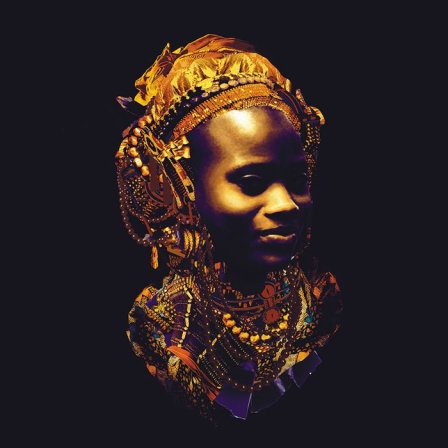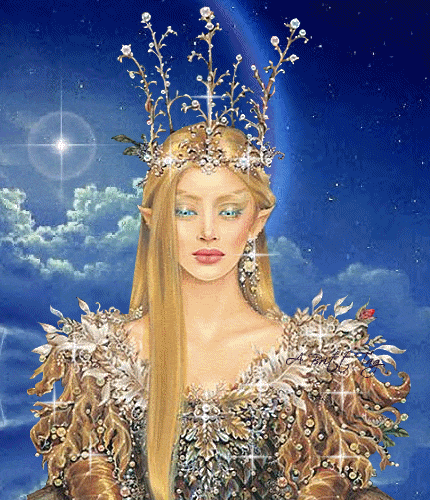
“Fauna” by Katrina Sesum
“Fauna’s themes are fertility, nature and divination. Her symbols are all forest items. In Roman mythology, Fauna is the consort to Faunus, whom this date venerates. With Faunus, She protects the woodlands and plants that live there. While Her role in stories seems minor, Fauna’s power lives on in botanical terminology, Her name having been given to vegetation.
Faunus was a woodland god like Pan, who sends messages through the forests for those who know nature’s omens and signs. If at all possible, go to a natural location today (even a park or a quiet tree in your neighborhood will do) with a small libation of wine or milk, both of which are customary. Pour this on the ground, focusing on your intention to learn more about nature’s messages to us. Then spend at least twenty minutes observing.
Take notes as you do. Do the trees’ leaves seem to talk? Do they move in a specific way? Are birds taking flight? Where do they go? Do any drop feathers on the ground? Do any animals appear unexpectedly? If so, what does the creature do, and where does it go? All these things, and other similar experiences, can carry a sign meant to help you today or in the days ahead.”
(Patricia Telesco, “365 Goddess: a daily guide to the magic and inspiration of the goddess”.)

“Fauna” by Charlie Terrell
Thalia Took writes a very in-depth piece on Fauna that I’d like to share with you; she writes: “Fauna is an old Roman Goddess of Prophecy and Fruitfulness, with ties to the forest and fields and the animals found there. She is closely related to the God Faunus; She is variously His wife, sister, or daughter. Her name, like Faunus’s, is from the Latin faveo, ‘to befriend, support, or back up’, from which we get our ‘favor’; an alternate etymology is from fari, ‘to speak, talk, or say’, referring to Their powers of prophecy. Her name then could be variously translated as ‘She Who Favors’, ‘the Friendly One’, ‘the Speaker’, or even ‘She Who Has Your Back’. She was identified with the prophetic Goddess Fatua, again meaning, ‘the Speaker’, but with additional meanings of ‘She Who Speaks Prophecy’, or ‘the Oracle’.
Fauna’s origins are in Latium, the land of the Latins, the people of the area around Rome, and She is closely associated with them. According to yet another of the Roman stories glorifying the city’s origins, Fauna was one of the Hyperborians, who were believed to live far in the north (hyperboreas in the Greek literally means ‘beyond the North Wind’), and said to worship Apollo. She hooked up with the hero Hercules and as a result gave birth to a son Latinus, later a king of the Latins, and therefore a mythical ancestor of the Roman people and a claim to the famous blood of Hercules. Faunus was Her second husband, Whom She married after Hercules left Her (per his usual modus operandi). Other stories reverse that, making Faunus Her original husband, and then make Her relationship with Hercules an extramarital affair. Still other stories name Faunus as the father of Latinus, by the river nymph Marica, Who was Herself identified with Aphrodite, the Greek Love Goddess.

“Courtesan” by *OtherworldCreations
In a similar vein, Fauna was sometimes judged to be a prostitute or courtesan; though this seems to be a late tale and may simply be a reaction to Her as a Goddess of Fertility. Her husband Faunus was sometimes said to be the same as the God Inuus, a God of sex, intercourse, and fertility, Whose name is supposedly from a Latin verb inire, ‘to copulate’; and since She is supposed to be the female equivalent of Faunus, that would make Her a Goddess of sex and copulation as well. Faunus was sometimes said to be the God for Whom the Lupercalia, a very old festival of purification and renewed fertility with strong sexual overtones, was celebrated; and two Faunalia, rural festivals of feasting and dancing, were celebrated to Them, on the Ides of February (the 13th, and in the old lunar calendar, the full moon) and the 5th of December.

Art by Jonathon Earl Bowser
In other legends however, Fauna is known for Her chastity and modesty; She was said to never leave Her grove or let a man look upon Her, and no man was allowed in Her temple. These tales are associated with the Bona Dea, ‘the Good Goddess’, said to be a cult name of Fauna. The Bona Dea, called so because Her true name was considered too sacred to be spoken aloud, is a Goddess of women and healing Whose worship was exclusive to women, men being forbidden to participate in Her rites. Perhaps Her virginity or chastity was a way of explaining why She would not allow men in Her rituals, and was the Roman way of rationalizing a Goddess Who was purely concerned with women.
Far more is known of Faunus than Fauna; His tales may perhaps shed some light on Her attributes and personality. Faunus was a very popular and ancient God Who protected and watched over livestock and Who haunted fields and the forest. As a prophetic God, He used both dreams and His own disembodied voice to reveal the future, and had a shrine in Tivoli at the grove of Albunea where prophetic dreaming was practiced. Their father was usually said to be the prophetic God Picus; though Their mother is not mentioned, Picus was famous for His devotion to Canens, a forest nymph known for Her beautiful singing voice.
Though myth is not necessarily that straightforward about things, Canens and Faunus do have a bit in common as They were both known as ‘the Voice of the Woods’. Canens in turn is associated with the witch Kirke, as Kirke was also enamoured of Picus, though She couldn’t steal Him away from Canens; and Latinus is sometimes said to be the son of Kirke and the famous Greek traveller and all-around tricksy guy Odysseus, or his son Telemakhos.
In some legends told of the Bona Dea, Faunus does not treat Her well at all; in one, She is His daughter; He lusts after Her, and when She rejects Him, He gets Her drunk and beats Her with sticks of myrtle, and then rapes Her as a serpent. In another, He beats Her to death, again with myrtle branches, for the crime of drinking. These legends seem to have been created to explain why both myrtle and wine played a part in the rites of the Bona Dea; they also emphasize Faunus’s wild, untamed and dangerous nature. The names Fauna and Faunus ‘the Friendly One(s)’ may well have been placating names, to keep the worshipper on Their good sides, much like the fairies of Celtic lore are called ‘the Good Folk’, so as to prevent any harm they might do. Fauna and Faunus were known to travel with an entourage of fauns (yes, like Mr. Tumnus, though without the Christian/Aslanic associations), wild and mischevious spirits of the countryside, equated with the satyrs of the Greeks, and believed to cause nightmares. Faunus Himself was identified with the Greek Pan, the Wild God par excellence.

“Fauna of a wood” by ~Selenaart
It would seem, then, that Fauna represents the thin line separating the wild from the untamed, as Goddess of both the dark mysterious forest and the cultivated fields, and Her very name is now used to refer to the animal kingdom, the fauna, (as opposed to the plant kingdom, called flora). As the Bona Dea was worshipped exclusively by women, Fauna is a Goddess of the wild sexuality of women, specifically sexual intercourse itself as an expression of the Life Force, and also of fertility (the latter was after all, until modern times and the invention of reliable contraception, a common result of the former). She brings prophecy through dreams and the voices of the wild places, and Her association with dreams and nightmares again connects to humanity’s dark and untamed nature. Several of the other Goddesses She is connected with were known as sorceresses and healers, such as Kirke and the Bona Dea (and by extension Angitia), which would make magic and healing another of Her attributes. All these Goddesses—The Bona Dea (and so majestic Maia as well) Angitia, Albunea, Canens, Marica, and even Kirke, whichever native Goddess She stands in for—can perhaps be thought of a constellation of related Goddesses of wild, magical, and sexual natures, possibly originally springing from the same source.” [1]

“Fauna” by ~Bizenghast
According to Judika Illes, “In addition to secret, mystic rites, Fauna was also very publicly a Goddess of physical healing. The sick were tended to in Her temple’s garden of medicinal herbs, essentially a sacred hospital. In Rome, snakes were associated with healing in general, but especially with women’s reproductive health. Snakes, Fauna’s sacred creature, were housed in Her temple gardens.

“Fatidica” by Lord Leighton
Iconography: Fauna is portrayed seated upon a throne, holding a cornucopia.
Creature: Snake
Element: Earth
Day: December 4th commemorates the anniversary of Her Mystery.
Offerings: There is controversy as to whether wine is forbidden from Fauna’s rites. One theory is that, because wine was once taboo for Roman women, any wine brought into Fauna’s temple was euphemistically called ‘milk’. Alternatively, the legend goes that wine and myrtle were banned because Faunus once got drunk and beat Fauna with a myrtle branch. That may be a euphemism for the myth in which Faunus rapes his daughter (who may also be his consort).” [2]
“Alternate spellings: Faula; Fatuai seems to be Her Oscan name.
Also called: Fatua, Fatuella; She was called Damia at Tarentum (a city originally founded by Greek colonists), a name that refers to the secret sacrifice made to the Bona Dea.” [3]
Sources:
Illes, Judika. The Encyclopedia of Spirits, “Fauna“.
Took, Thalia. Thaliatook.com, “Fauna“.
Suggested Links:
Ladyoftheabyss. Witchesofthecraft.com, “Earth Goddesses – FAUNA“.
Took, Thalia. Thaliatook.com, “The Bona Dea“.
Wikipedia, “Fauna (goddess)“.
 Also, from Patricia Telesco’s book, 365 Goddess:A Daily Guide to the Magic and Inspiration of the Goddess, she states in her February 14th entry on Venus and Lupercalia: “During Lupercalia, an ancient predecessor of Valentine’s Day, single girls put their names in a box and unmarried men drew lots to see with whom they would be paired off for the coming year. To be more modern-minded, try pinning five bay leaves to your pillow instead to dream of future loves. If you’re married or otherwise involved, steep the bay leaves in water and drink the resulting tea to strengthen the love in your relationship.
Also, from Patricia Telesco’s book, 365 Goddess:A Daily Guide to the Magic and Inspiration of the Goddess, she states in her February 14th entry on Venus and Lupercalia: “During Lupercalia, an ancient predecessor of Valentine’s Day, single girls put their names in a box and unmarried men drew lots to see with whom they would be paired off for the coming year. To be more modern-minded, try pinning five bay leaves to your pillow instead to dream of future loves. If you’re married or otherwise involved, steep the bay leaves in water and drink the resulting tea to strengthen the love in your relationship.









































